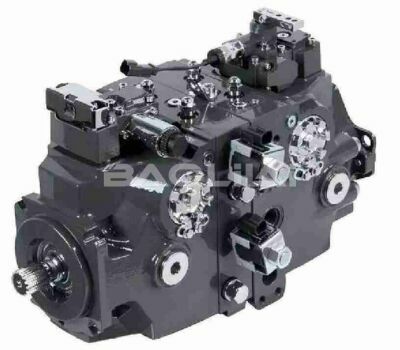Analysis of common causes of plunger pump slipper falling off
A detached slipper on a piston pump can be a serious problem as it can lead to reduced pump performance and possible damage. There may be several causes for this problem, and the solution may vary depending on the situation. The following are some common causes and solutions for plunger pump sliding shoes falling off:
1. Wear: Over time, the slipper wears, which can cause it to loosen or separate from the plunger.
Solution: Regular maintenance is crucial. Check the sliding shoes for signs of wear and replace if necessary. Also, make sure the shoes are fastened correctly and that all fastening devices, such as bolts or clamps, are in good condition.
2. Excessive pressure: Operating the pump at pressures beyond its design limits may cause increased stress on the slipper and its accessories.
Solution: Make sure the pump is operating within its specified pressure range. If higher pressure is required, consider upgrading to a pump designed for such conditions.
3. Improper installation: If the sliding shoes are not installed or fixed correctly during assembly or maintenance, the sliding shoes may become loose.
Solution: Make sure the slider is installed and secured correctly according to the manufacturer's guidelines. Follow the recommended torque settings for any fasteners involved.
H1-P-165-R-C-A-A3-C1-N-D5-G-G3-H4-K-35-K-35-L-M-24-PN-NNN-NNN H1P165RCAA3C1ND5GG3H4K35K35LM24PNNNNNNN
H1-P-165-R-C-A-A3-C1-N-D5-G-G2-H4-K-35-K-35-L-M-24-PN-NNN-NNN H1P165RCAA3C1ND5GG2H4K35K35LM24PNNNNNNN
H1-P-165-R-C-A-A3-C1-N-D3-G-G3-H3-K-35-K-35-A-M-24-PN-NNN-NNN H1P165RCAA3C1ND3GG3H3K35K35AM24PNNNNNNN
H1-P-165-R-C-A-A3-C1-B-D6-G-G3-H3-L-35-L-20-A-L-24-PN-NNN-NNN H1P165RCAA3C1BD6GG3H3L35L20AL24PNNNNNNN
H1-P-165-R-C-A-A3-C1-B-D3-G-G3-NN-L-35-L-35-L-M-24-PN-NNN-NNN H1P165RCAA3C1BD3GG3NNL35L35LM24PNNNNNNN
H1-P-165-R-C-A-A2-C3-N-D8-G-G3-NN-L-23-L-23-A-P-24-PN-NNN-NNN H1P165RCAA2C3ND8GG3NNL23L23AP24PNNNNNNN
H1-P-165-R-C-A-A2-C3-N-D8-G-G3-H2-K-45-K-45-N-E-26-PN-NNN-NNN H1P165RCAA2C3ND8GG3H2K45K45NE26PNNNNNNN
H1-P-165-R-C-A-A2-C3-N-D6-G-G3-NN-L-38-L-38-L-L-24-PN-NNN-NNN H1P165RCAA2C3ND6GG3NNL38L38LL24PNNNNNNN
H1-P-165-R-C-A-A2-C2-N-D9-G-G2-H4-L-42-L-42-L-L-24-PN-NNN-NNN H1P165RCAA2C2ND9GG2H4L42L42LL24PNNNNNNN
H1-P-165-R-C-A-A2-C2-N-D8-G-G3-NN-L-42-L-42-A-P-20-PN-NNN-NNN H1P165RCAA2C2ND8GG3NNL42L42AP20PNNNNNNN
H1-P-165-R-C-A-A2-C2-N-D8-G-G3-H5-L-33-L-33-L-P-24-PN-NNN-NNN H1P165RCAA2C2ND8GG3H5L33L33LP24PNNNNNNN
H1-P-165-R-C-A-A2-C2-N-D8-G-G3-H3-L-42-L-42-A-P-20-PN-NNN-NNN H1P165RCAA2C2ND8GG3H3L42L42AP20PNNNNNNN
H1-P-165-R-C-A-A2-C2-N-D8-G-G3-H2-L-42-L-42-L-P-24-PN-NNN-NNN H1P165RCAA2C2ND8GG3H2L42L42LP24PNNNNNNN
H1-P-165-R-C-A-A2-C2-N-D8-G-G2-NN-L-42-L-42-L-P-24-PN-NNN-NNN H1P165RCAA2C2ND8GG2NNL42L42LP24PNNNNNNN
H1-P-165-R-C-A-A2-C2-N-D8-G-G2-NN-L-42-L-42-A-P-24-PN-NNN-NNN H1P165RCAA2C2ND8GG2NNL42L42AP24PNNNNNNN
H1-P-165-R-C-A-A2-C2-N-D8-G-G2-H6-L-42-L-42-A-P-24-PN-NNN-NNN H1P165RCAA2C2ND8GG2H6L42L42AP24PNNNNNNN
H1-P-165-R-C-A-A2-C2-N-D8-G-G2-H6-L-38-L-38-L-P-24-PN-NNN-NNN H1P165RCAA2C2ND8GG2H6L38L38LP24PNNNNNNN
H1-P-165-R-C-A-A2-C2-N-D8-G-G2-H3-L-35-L-35-L-P-24-PN-NNN-NNN H1P165RCAA2C2ND8GG2H3L35L35LP24PNNNNNNN
H1-P-165-R-C-A-A2-C2-N-D8-G-G2-H2-L-35-L-35-L-P-24-PN-NNN-NNN H1P165RCAA2C2ND8GG2H2L35L35LP24PNNNNNNN
H1-P-165-R-C-A-A2-C2-N-D7-G-G2-H4-L-42-L-42-L-P-24-PN-NNN-NNN H1P165RCAA2C2ND7GG2H4L42L42LP24PNNNNNNN
4. Chemical Compatibility: Exposure to corrosive or abrasive liquids will accelerate the degradation of the shoe and its accessories.
Solution: Choose materials for the slip shoe and its accessories that are compatible with the fluid being pumped. Check regularly for signs of corrosion or wear and replace components as necessary.
5. Vibration and shock: Excessive vibration or shock in the pump system can cause components to loosen, including sliding shoes.
Solution: Address the root causes of vibration and shock in your system. This may involve checking for misalignment, loose bolts, or worn bearings. Installing shock absorbers or shock mounts may also help.
6. Insufficient lubrication: Lack of proper lubrication can lead to increased friction and wear of the sliding shoe and its accessories.
Solution: Make sure the shoe and related components are adequately lubricated per manufacturer's recommendations. Regularly monitor and maintain lubrication systems.
7. Environmental conditions: Extreme temperatures, humidity or exposure to contaminants may affect the integrity of the boot and its accessories.
Solution: Store and operate the pump within its specifications. Consider protective measures such as temperature control or environmental containment as needed.

8. Material Quality: If a shoe or its accessories are made of inferior materials or have manufacturing defects, they may be more susceptible to failure.
9. Tightening and torque: Regularly check the fasteners (bolts, nuts, retaining clips, etc.) that secure the sliding shoe. Over time, they can become loose due to vibration or thermal expansion and contraction.
Solution: Implement a torque check program to ensure fasteners remain properly tightened. If necessary, use a calibrated torque wrench to retighten to the manufacturer's recommended torque value.
10. Plunger alignment: A misaligned plunger or piston can place uneven stress on the shoe, potentially causing it to separate.
Solution: Make sure the plunger or piston is properly aligned and centered within the pump. Adjust any misalignment or deflection issues that may be causing the problem.
11. Use a backup system: In critical applications, consider using a backup system or dual sliding shoes to minimize the risk of pump failure if one of the sliding shoes becomes detached.
Solution: Install redundant shoes and mechanisms to ensure the pump continues to operate even if one of the shoes fails. This is especially important in applications where downtime is costly or hazardous.
12. Regular inspection: Regularly check the sliding shoes and their accessories for signs of wear, damage or looseness. A proactive maintenance approach can prevent catastrophic failures.
Solution: Develop a comprehensive inspection and maintenance schedule and stick to it. Replace shoes and components in a planned manner rather than waiting for them to fail.
H1-P-165-R-C-A-A2-C2-N-D6-G-G3-NN-L-23-L-23-L-L-24-PN-NNN-NNN H1P165RCAA2C2ND6GG3NNL23L23LL24PNNNNNNN
H1-P-165-R-C-A-A2-C2-N-D6-G-G3-H3-L-42-L-42-L-L-24-PN-NNN-NNN H1P165RCAA2C2ND6GG3H3L42L42LL24PNNNNNNN
H1-P-165-R-C-A-A2-C2-N-D6-G-G3-H2-L-35-L-35-L-L-24-PN-NNN-NNN H1P165RCAA2C2ND6GG3H2L35L35LL24PNNNNNNN
H1-P-165-R-C-A-A2-C2-N-D3-L-G3-H3-L-35-L-35-A-M-24-P4-NNN-NNN H1P165RCAA2C2ND3LG3H3L35L35AM24P4NNNNNN
H1-P-165-R-C-A-A2-C2-N-D3-G-G3-NN-L-35-L-20-L-M-24-PN-NNN-NNN H1P165RCAA2C2ND3GG3NNL35L20LM24PNNNNNNN
H1-P-165-R-C-A-A2-C2-N-D3-G-G3-H6-L-35-L-35-L-M-24-PN-NNN-NNN H1P165RCAA2C2ND3GG3H6L35L35LM24PNNNNNNN
H1-P-165-R-C-A-A2-C2-N-D3-G-G3-H6-L-30-L-40-L-M-28-PN-NNN-NNN H1P165RCAA2C2ND3GG3H6L30L40LM28PNNNNNNN
H1-P-165-R-C-A-A2-C2-N-D3-G-G3-H6-K-45-K-42-L-M-28-PN-NNN-NNN H1P165RCAA2C2ND3GG3H6K45K42LM28PNNNNNNN
H1-P-165-R-C-A-A2-C2-N-D3-G-G3-H2-L-20-L-20-A-M-24-PN-NNN-NNN H1P165RCAA2C2ND3GG3H2L20L20AM24PNNNNNNN
H1-P-165-R-C-A-A2-C2-N-D3-G-G2-NN-L-42-L-42-L-M-24-PN-NNN-NNN H1P165RCAA2C2ND3GG2NNL42L42LM24PNNNNNNN
H1-P-165-R-C-A-A2-C2-B-D6-G-G3-NN-L-33-L-33-L-L-28-PN-NNN-NNN H1P165RCAA2C2BD6GG3NNL33L33LL28PNNNNNNN
H1-P-165-R-C-A-A2-C2-B-D6-G-G2-H3-L-30-L-20-L-L-24-PN-NNN-NNN H1P165RCAA2C2BD6GG2H3L30L20LL24PNNNNNNN
H1-P-165-L-C-A-P9-C2-D-D6-L-G2-H6-L-40-L-40-L-L-26-P2-NNN-D6F H1P165LCAP9C2DD6LG2H6L40L40LL26P2NNND6F
H1-P-165-L-C-A-P7-C2-C-D3-L-G2-H6-L-42-L-42-L-M-26-P2-NNN-D4F H1P165LCAP7C2CD3LG2H6L42L42LM26P2NNND4F
H1-P-165-L-C-A-F2-C2-D-D8-G-G3-NN-F-02-F-02-L-P-26-P1-NNN-NNN H1P165LCAF2C2DD8GG3NNF02F02LP26P1NNNNNN
H1-P-165-L-C-A-F2-C2-D-D8-G-F3-NN-F-02-F-02-L-P-24-P1-NNN-NNN H1P165LCAF2C2DD8GF3NNF02F02LP24P1NNNNNN
H1-P-165-L-C-A-E8-C3-N-D3-G-G2-H6-L-38-L-38-L-M-26-PN-NNN-NNN H1P165LCAE8C3ND3GG2H6L38L38LM26PNNNNNNN
H1-P-165-L-C-A-E8-C2-N-D8-G-G3-H2-L-35-L-20-L-P-24-PN-NNN-NNN H1P165LCAE8C2ND8GG3H2L35L20LP24PNNNNNNN
H1-P-165-L-C-A-E8-C2-N-D6-G-G2-H6-L-38-L-20-L-L-24-PN-NNN-NNN H1P165LCAE8C2ND6GG2H6L38L20LL24PNNNNNNN
H1-P-165-L-C-A-B1-C1-B-D8-G-G2-NN-L-35-L-35-N-E-24-PN-NNN-NNN H1P165LCAB1C1BD8GG2NNL35L35NE24PNNNNNNN
13. Material Upgrade: If you have been having problems with your slippers coming off, consider upgrading to materials that are more resistant to wear, corrosion, or abrasion.
Solution: Consult with the manufacturer or engineering expert to determine which material is better suited to the specific conditions of your application.
14. Operator training: Ensure that pump operators are adequately trained on the correct procedures for operating and maintaining plunger pumps.
Solution: Training and knowledge of pump operation and maintenance can go a long way in preventing problems. Well-informed operators are more likely to spot potential problems and resolve them promptly.
15. Consult Manufacturer’s Guidelines: Always refer to the manufacturer’s guidelines and recommendations for the specific model of piston pump you are using. They often provide valuable information on maintenance, troubleshooting, and best practices.
Keep in mind that plunger pump system designs and specifications can vary, so solutions to prevent slipper shoes from falling off should be tailored to your specific equipment and operating conditions. Regular monitoring, maintenance and proactive resolution of potential problems can significantly extend the life and reliability of a plunger pump. If you encounter recurring problems or have concerns, it is recommended to consult a qualified engineer or pump manufacturer for expert guidance.
This article is published by the official website of Baolilai Hydraulics, please contact the author and indicate the source for reprinting:https://www.baolilai-pump.cn/news/1146.html






